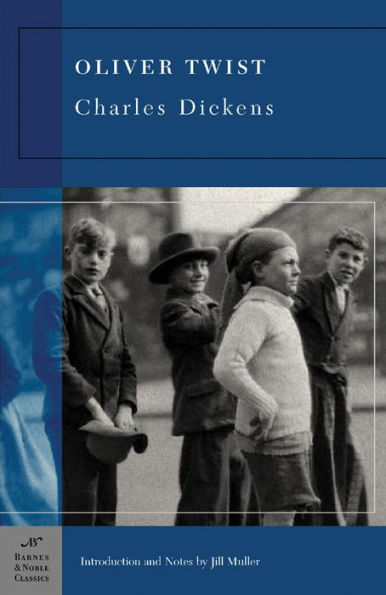Read an Excerpt
From Jill Mullers Introduction to Oliver Twist
Second novels separate the sheep from the goats, the possessors of enduring talent from the mere purveyors of flash-in-the-pan literary sensation. Many writers embark on a second novel with a good deal of trepidation, especially if their first book has achieved the kind of instant acclaim awarded to Charles Dickenss Pickwick Papers. If Dickens experienced any such anxiety when he set out to write Oliver Twist, he countered it with his lifelong drug of choice, a frenetic and compulsive productivity. Appearing in monthly installments, the usual mode of publication for novels until late in the nineteenth century, Oliver Twist was mostly written in tandem with other projects. When the first two chapters were published in Bentleys Miscellany in February 1837, Dickens was still writing Pickwick Papers as a serial for Chapman and Hall. With Pickwick Papers completed in November 1837, the twenty-five-year-old Dickens devoted himself to Oliver Twist for a mere four months before beginning a third novel, Nicholas Nickleby. Oliver Twist was finished and published in three volumes in November 1838, while the serial version in Bentleys still had five months to run. This frenzied pace of production was halted only once, in June 1837, when the intensity of his grief over the sudden death of his seventeen-year-old sister-in-law, Mary Hogarth, forced Dickens to postpone that months installments of both Pickwick Papers and Oliver Twist. Mary Hogarth is memorialized as Rose Maylie in Oliver Twist.
Where many young writers would have been tempted to stay with a winning formula, Dickenss second novel was a total departure from the timeless comedic world of Pickwick Papers. The first three installments of Oliver Twist employed ferocious satire to address a contemporary social evil, the sufferings of the poor in the new workhouses mandated by the 1834 Poor Law Amendment Act. Then, with the introduction of Fagin and his gang of juvenile pickpockets in the fourth installment, Dickenss readers found themselves plunged into Londons criminal underworld. The novels final installment contained a gruesome murder, a manhunt, and a hanging. While a few readers, such as the Prime Minister, Lord Melbourne, were shocked by Dickenss turn to such sordid subject matter, many more, including nineteen-year-old Queen Victoria, were enthralled. Oliver Twist was every bit as popular as Pickwick Papers. Three dramatizations played in London theaters during the winter of 1838-1839. Perfectly complemented by George Cruikshanks quirky illustrations, the novel was in a third edition by 1841, and even spawned an imitation, Thomas Prests Oliver Twiss. It remained a bestseller through Dickenss lifetime and beyond. The penny edition of 1871 sold 150,000 copies in three weeks. During the last decade of his life, Dickens toured England, Ireland, and America, giving public readings of favorite sections from his novels. "Sikes and Nancy," based on chapter XLVII of Oliver Twist, was a particular favorite of both author and audience. While Dickenss rendition of Nancys brutal murder sent audiences into fits of screaming and fainting, a physician waited backstage to monitor the ailing authors pulse rate. Dickenss friend and biographer John Forster speculated that the energy and fervor with which Dickens threw himself into these performances may have contributed to his early death from heart disease in 1870.
Oliver Twist remains one of the best known and most popular of Dickenss novels. Translated, adapted, dramatized, filmed (most notably by David Lean in 1948), and even turned into a musical, the story of Little Orphan Oliver and his grotesque tormentors has passed into popular culture. Millions of people who have never opened the nineteenth-century novel are familiar with the image of a ragged child holding out his porringer and asking for more. Like Robinson Crusoe or Huck Finn, Oliver has evolved from fiction into fable and archetype. Or perhaps he has simply returned to his roots. The characters and settings of Oliver Twist resonate so deeply and so variously because they echo a diverse collection of popular genres. The novel is at once social satire, thriller, melodrama, autobiography, fairy tale, moral fable, and religious allegory. While some of the specific texts that influenced Oliver Twists composition are no longer familiar to contemporary readers and may require some literary excavation, each of the various genres whose competing voices create the novels seductive energy survive and are easily recognizable in modern forms of entertainment.
Like its predecessor, Pickwick Papers, Dickenss second novel reflects his childhood passion for the eighteenth-century picaresque novels Tom Jones and Roderick Random. As in the novels by Henry Fielding and Tobias Smollett, the plot of Oliver Twist revolves around illegitimacy and disputed inheritance. Like his literary forebears, Oliver is unaware of his true identity and adrift in a world of rogues and schemers. Unlike the more robust heroes of Fielding and Smollett, however, Dickenss orphan does not grow up; he remains a frail and passive child throughout the novel, more victim than protagonist. Olivers failure to reach adolescence preserves him from the sexual temptations that befall Tom Jones and Roderick Random, perhaps making it easier for Dickens to persuade his Victorian audience that "little Oliver" embodies "the purest good."


